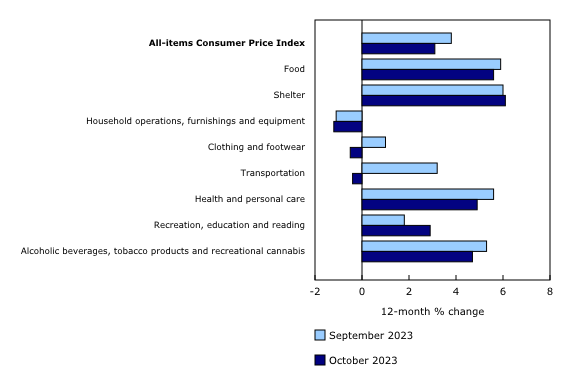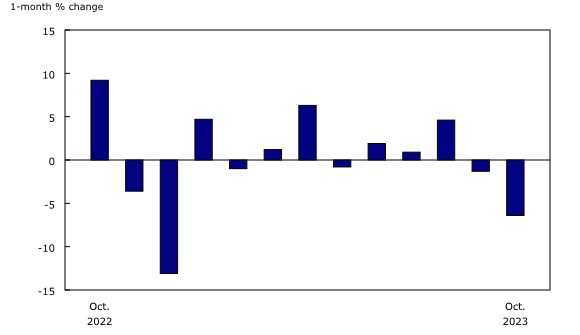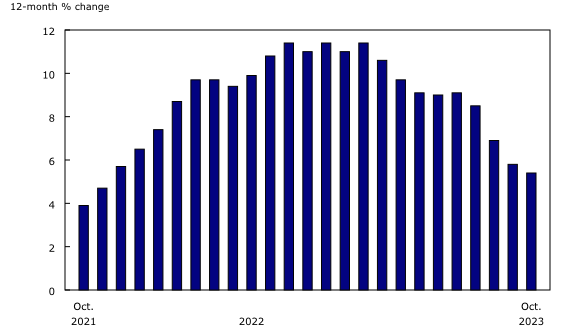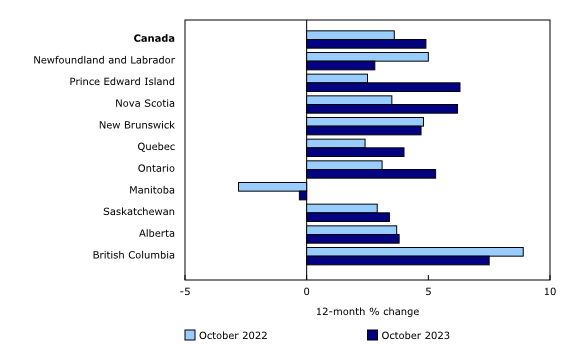Consumer Price Index, October 2023
Released: 2023-11-21
October 2023
3.1% 
(12-month change)
In October, the Consumer Price Index (CPI) rose 3.1% on a year-over-year basis, down from a 3.8% gain in September. The year-over-year deceleration was largely a result of lower prices for gasoline (-7.8%) in October. Excluding gasoline, the CPI rose 3.6% in October, following a 3.7% increase in September.
While prices for goods (+1.6%) decelerated, led by lower prices at the pump, prices for services (+4.6%) rose at a faster pace in October, largely driven by higher prices for travel tours, rent and property taxes and other special charges.
The largest contributors to the year-over-year CPI increase continued to be mortgage interest cost, food purchased from stores and rent.
On a monthly basis, the CPI rose 0.1% in October, following a 0.1% decline in September. The monthly increase was largely driven by travel tours and property taxes and other special charges, which are priced annually in October. On a seasonally adjusted monthly basis, the CPI fell 0.1%.
Prices at the pump decline
On a year-over-year basis, consumers paid 7.8% less for gasoline in October after a 7.5% increase in September. The decline in October was partly driven by a base-year effect, as prices increased 9.2% on a monthly basis in October 2022 when the Organization of the Petroleum Exporting Countries Plus announced production cuts.
In October 2023, prices for gasoline fell 6.4% month over month. The decline was largely due to lower refining margins, which were partly driven by producers switching to cheaper winter blends.
Grocery prices continue to decelerate, but remain elevated
While grocery prices remained at elevated levels, they also continued their trend of slower year-over-year growth, with a 5.4% increase in October following a 5.8% gain in September. While deceleration continued to be broad-based, fresh vegetables (+5.0%) contributed the most to the slowdown.
Service prices rise at a faster pace
Prices for services put upward pressure on the CPI in October, rising 4.6% on a year-over-year basis, following a 3.9% increase in September.
Canadians continued to feel the impact of rising prices for rent, which rose at a faster pace year over year in October (+8.2%) than in September (+7.3%). The national increase reflected acceleration across most provinces. The largest increases in rent prices were seen in Nova Scotia (+14.6%), Alberta (+9.9%), British Columbia (+9.1%) and Quebec (+9.1%).
Property taxes and other special charges, which are priced annually in October, rose 4.9% on a year-over-year basis, compared with a 3.6% increase in October 2022. The national increase in October 2023 was the largest since October 1992, with homeowners paying more in all but one province, as municipalities required larger budgets to cover rising costs. Property taxes in Manitoba (-0.3%) declined for the third consecutive year, mainly due to a reduction in the provincial education tax.
Prices for travel tours rose 11.3% year over year in October after a decline of 2.2% in September, with faster price growth largely driven by travel to destinations in the United States.
November is Financial Literacy Month
We have made new products available during Financial Literacy Month in November.
Check out Statistics Canada's new Food Price Data Hub, which features a variety of food price related statistics, articles and tools.
To find a list of all recent publications regarding the Consumer Price Index (CPI), consult our Recent Analytical Products page.
Statistics Canada has released an infographic, "The rise in prices for wheat-based food products, 2023." This infographic details the food supply chain by focusing on the price movements for wheat-based food products in 2023, and the costs to move food products from producers to consumers.
Check out the Personal Inflation Calculator. This interactive calculator allows you to enter dollar amounts in the common expense categories to produce a personalized inflation rate, which you can compare to the official measure of inflation for the average Canadian household—the CPI.
Browse the Consumer Price Index Data Visualization Tool to access current (Latest Snapshot of the CPI) and historical (Price trends: 1914 to today) CPI data in a customizable visual format.
Regional highlights
Year over year, prices increased in all provinces in October but at a slower pace compared with September.
Electricity prices rise at a slower pace in Alberta
On a year-over-year basis, consumers in Alberta paid 45.4% more for electricity in October, down from a 113.0% increase in September. The deceleration was largely a result of a 20.0% month-over-month price decline, coinciding with easing demand.
Prices for natural gas decline in three Western provinces
On a month-over-month basis, natural gas prices fell in Saskatchewan (-6.4%), Alberta (-1.6%) and British Columbia (-6.1%) in October. The declines were a result of lower commodity prices.
Note to readers
Visit the Consumer Price Index portal to find all Consumer Price Index (CPI) data, publications, interactive tools and announcements highlighting new products and upcoming changes to the CPI in one convenient location.
Real-time data tables
Real-time data table 18-10-0259-01 will be updated on December 4. For more information, consult the document "Real-time data tables."
Next release
The Consumer Price Index for November will be released on December 19.
Products
The "Consumer Price Index Data Visualization Tool" is available on the Statistics Canada website.
More information on the concepts and use of the Consumer Price Index (CPI) is available in The Canadian Consumer Price Index Reference Paper (62-553-X).
For information on the history of the CPI in Canada, consult the publication Exploring the First Century of Canada's Consumer Price Index (62-604-X).
Two videos, "An Overview of Canada's Consumer Price Index (CPI)" and "The Consumer Price Index and Your Experience of Price Change," are available on Statistics Canada's YouTube channel.
Find out answers to the most common questions posed about the CPI in the context of the COVID-19 pandemic and beyond.
Contact information
For more information, or to enquire about the concepts, methods or data quality of this release, contact us (toll-free 1-800-263-1136; 514-283-8300; infostats@statcan.gc.ca) or Media Relations (statcan.mediahotline-ligneinfomedias.statcan@statcan.gc.ca).
- Date modified:








